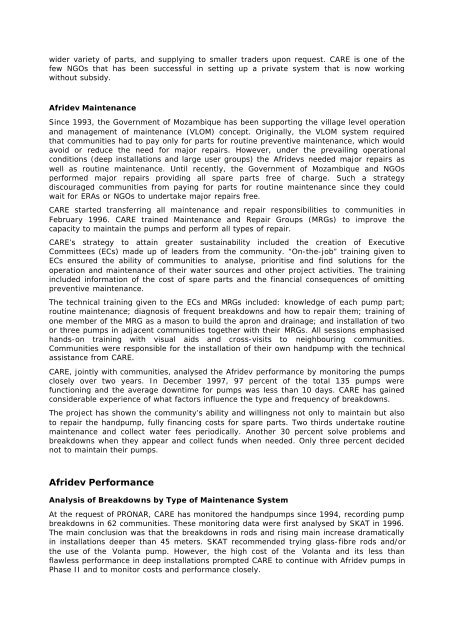Mozambique - The Water, Sanitation and Hygiene
Mozambique - The Water, Sanitation and Hygiene
Mozambique - The Water, Sanitation and Hygiene
- No tags were found...
Create successful ePaper yourself
Turn your PDF publications into a flip-book with our unique Google optimized e-Paper software.
wider variety of parts, <strong>and</strong> supplying to smaller traders upon request. CARE is one of thefew NGOs that has been successful in setting up a private system that is now workingwithout subsidy.Afridev MaintenanceSince 1993, the Government of <strong>Mozambique</strong> has been supporting the village level operation<strong>and</strong> management of maintenance (VLOM) concept. Originally, the VLOM system requiredthat communities had to pay only for parts for routine preventive maintenance, which wouldavoid or reduce the need for major repairs. However, under the prevailing operationalconditions (deep installations <strong>and</strong> large user groups) the Afridevs needed major repairs aswell as routine maintenance. Until recently, the Government of <strong>Mozambique</strong> <strong>and</strong> NGOsperformed major repairs providing all spare parts free of charge. Such a strategydiscouraged communities from paying for parts for routine maintenance since they couldwait for ERAs or NGOs to undertake major repairs free.CARE started transferring all maintenance <strong>and</strong> repair responsibilities to communities inFebruary 1996. CARE trained Maintenance <strong>and</strong> Repair Groups (MRGs) to improve thecapacity to maintain the pumps <strong>and</strong> perform all types of repair.CARE’s strategy to attain greater sustainability included the creation of ExecutiveCommittees (ECs) made up of leaders from the community. “On-the-job” training given toECs ensured the ability of communities to analyse, prioritise <strong>and</strong> find solutions for theoperation <strong>and</strong> maintenance of their water sources <strong>and</strong> other project activities. <strong>The</strong> trainingincluded information of the cost of spare parts <strong>and</strong> the financial consequences of omittingpreventive maintenance.<strong>The</strong> technical training given to the ECs <strong>and</strong> MRGs included: knowledge of each pump part;routine maintenance; diagnosis of frequent breakdowns <strong>and</strong> how to repair them; training ofone member of the MRG as a mason to build the apron <strong>and</strong> drainage; <strong>and</strong> installation of twoor three pumps in adjacent communities together with their MRGs. All sessions emphasisedh<strong>and</strong>s-on training with visual aids <strong>and</strong> cross-visits to neighbouring communities.Communities were responsible for the installation of their own h<strong>and</strong>pump with the technicalassistance from CARE.CARE, jointly with communities, analysed the Afridev performance by monitoring the pumpsclosely over two years. In December 1997, 97 percent of the total 135 pumps werefunctioning <strong>and</strong> the average downtime for pumps was less than 10 days. CARE has gainedconsiderable experience of what factors influence the type <strong>and</strong> frequency of breakdowns.<strong>The</strong> project has shown the community’s ability <strong>and</strong> willingness not only to maintain but alsoto repair the h<strong>and</strong>pump, fully financing costs for spare parts. Two thirds undertake routinemaintenance <strong>and</strong> collect water fees periodically. Another 30 percent solve problems <strong>and</strong>breakdowns when they appear <strong>and</strong> collect funds when needed. Only three percent decidednot to maintain their pumps.Afridev PerformanceAnalysis of Breakdowns by Type of Maintenance SystemAt the request of PRONAR, CARE has monitored the h<strong>and</strong>pumps since 1994, recording pumpbreakdowns in 62 communities. <strong>The</strong>se monitoring data were first analysed by SKAT in 1996.<strong>The</strong> main conclusion was that the breakdowns in rods <strong>and</strong> rising main increase dramaticallyin installations deeper than 45 meters. SKAT recommended trying glass-fibre rods <strong>and</strong>/orthe use of the Volanta pump. However, the high cost of the Volanta <strong>and</strong> its less thanflawless performance in deep installations prompted CARE to continue with Afridev pumps inPhase II <strong>and</strong> to monitor costs <strong>and</strong> performance closely.
















